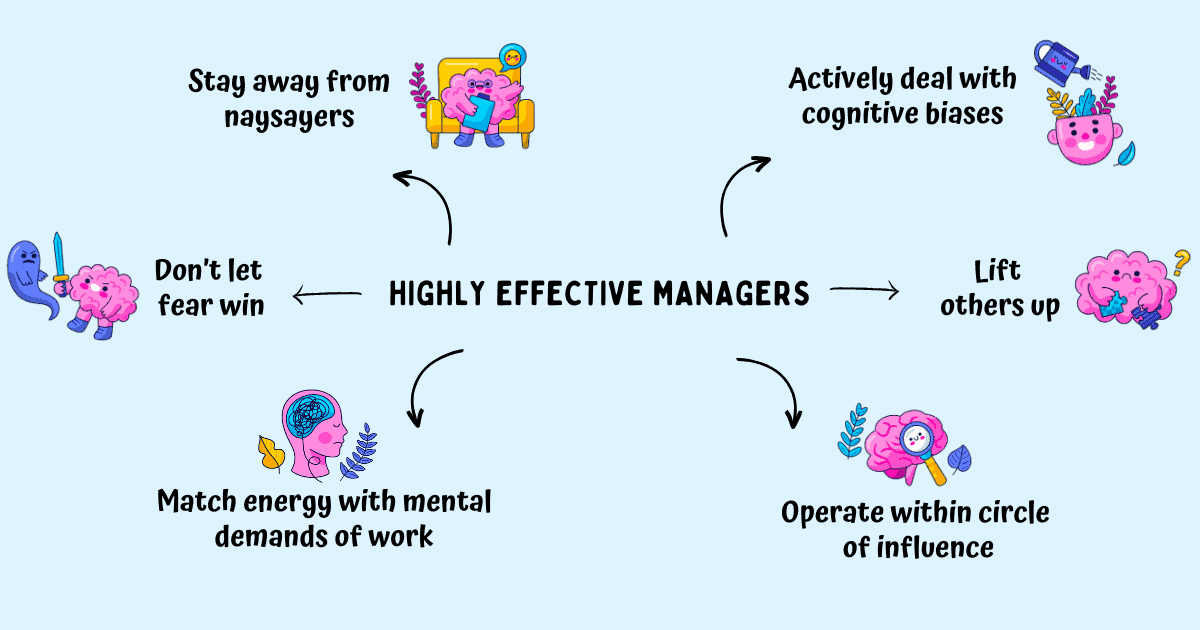5 Questions to Ask Your Managers Every Month to Help Them Grow as a Leader

When you stop managing individual contributors and start managing other managers, a lot needs to change. Your role is no longer about assigning tasks, meeting deadlines or taking care of your team’s work assignments and other responsibilities. Your managers are now doing the work you used to do yourself.
You can’t do their work.
You can’t make their decisions for them.
You can’t be involved in day-to-day priorities.
So, how can you let go of the control? How can you trust them to do the job while you’re still responsible for it?
You need to invest in their growth. You need to give them full ownership while holding them accountable to take their job seriously. However, most leaders get this wrong. They’re either:
- Too involved: Being too involved in day-to-day decisions not only impacts your effectiveness as a leader, it leaves less room for your manager to learn and grow.
- Too disconnected: You may fail to see when they’re struggling. Every missed opportunity to coach and guide them diminishes their potential.
To turn your managers into successful leaders, don’t be too involved or too disconnected. Find the sweet spot where you know just enough to coach when needed while giving them the space to explore, work things out on their own and learn from their mistakes.
The temptation to lead as a chess master, controlling each move of the organization, must give way to an approach as a gardener, enabling rather than directing. A gardening approach to leadership is anything but passive. The leader acts as an “Eyes-On, Hands-Off” enabler who creates and maintains an ecosystem in which the organization operates.
― Stanley McChrystal, Team of Teams
A monthly practice that helped me do this well involves asking these 5 questions to each of my managers.
What concerns did your team raise last month and how did you address them?
There’s often a wide gap between how your manager thinks about their team’s performance and how they actually view their growth. Not taking the time to understand their frustrations, motivations and desires can widen this gap.
Are they concerned about the growth opportunities?
Do they think they’re fairly compensated?
How do they find the culture of the team and their organization?
Asking your managers about their team’s biggest concerns enables you to judge two key areas:
- Are your managers spending time doing their one-on-ones and making an effort to understand key areas that hurt their team’s productivity and performance?
- Are they actually addressing their team’s issues or simply making false promises?
Managers who ignore their team’s reality, put off difficult conversations or try to ignore conflict limit their team’s potential. Ignoring their challenges turns them cynical, judgmental and dissatisfied. Disgruntled employees can’t give their 100% on the job. They can’t contribute at their highest levels of skills and abilities.
If your manager isn’t doing so well in this area, help them understand the negative impact of leaving unresolved issues, coach them to take a peek into their team’s mindset and guide them to gradually make their team’s concerns a priority.
What was the biggest impact created by your team last month and what contributed to it?
Understanding your manager’s biggest contributions gives you a sense into where their team is spending time—work that adds value to the organization or inconsequential time wasting activities.
Asking this question will not only give you inputs on what’s working well for the team but also what prevented them from doing even better. Your manager is most likely to share their own challenges, frustrations and other problems that limit their team’s outcomes and impact.
What behaviors are making employees stick and work together?
What behaviors are pulling them apart?
How is their time divided? Where are they spending the majority of their time?
For example: you may learn that more time is wasted in managing conflicting priorities and less in doing real work because of mis-alignment of expectations at the leadership level.
You can problem solve with your managers and other leaders of the organization on how to resolve these issues. You can give them the support needed to work on more high impact projects and waste less time in resolving communication, collaboration and other such issues.
And if it turns out that it’s your manager who isn’t prioritizing well, try to understand their decision making process and coach them on how to make better decisions that are aligned with the growth of the organization and success of the team.
Skip Level Meeting Questions + Template
Use these skip level meeting questions with indirect reports to bridge the gap, get a better perspective on how things are going and maintain a human connection with each person on your team.
What issues, conflicts and disagreements got your significant time and attention. Why were they important?
If your managers are doing their jobs well, they will be dealing with plenty of conflicts and disagreements on a daily basis, not less. Many leaders think disagreements are bad or they’re a sense of incompetence. They resist it themselves and try to save their managers from it as well.
As a leader you should be concerned if your managers are:
- Not saying no enough.
- Prioritizing everything that their stakeholders ask without ensuring it’s the right thing for the team.
- Pressurizing their team to keep up with unreasonable deliveries and timelines just to keep their counterparts happy.
- Not speaking up enough or raising their concerns.
- Hiding important issues and not seeking help with the belief others will think less of them.
Their ego or outdated beliefs can get in the way of their effectiveness unless you as their manager point it out and help them see how their behavior is damaging to their team’s output and the success of their organization.
Asking this question every month signals to your managers that they need to stand out and not fit in. It helps normalize disagreements. If your managers are painting a rosy picture and only talking about things that are going well without the ones that are actually keeping them busy, consider it as a red flag and dig deeper.
Many of us say yes to things because we are eager to please and make a difference. Yet the key to making our highest contribution may well be saying no. As Peter Drucker said, “People are effective because they say ‘no,’ because they say, ‘this isn’t for me.”
― Greg McKeown, Essentialism
What were the key takeaways from the discussions you had last month with stakeholders or other cross functional leaders/managers?
There’s often a gap between strategy from the top and execution on the ground. When the quarterly planning finishes, everyone appears to be aligned. However, once teams disperse and start executing independently, new discussions and new learnings change the plan—old assumptions that are no longer true, change of requirements or ad hoc requests from stakeholders who can’t make up their mind on what they want.
The biggest problem is such decisions are sometimes made in silos and people who must be informed are kept out of the loop. This leads to surprises, misalignment and time wasted in doing work that was either not required or not in line with the expectations.
Asking this question keeps you informed of such changes. You can learn about decisions that may be wrong and course correct if needed. Understanding your stakeholders’ concerns, disagreements or other such issues is also an excellent opportunity for you to coach your managers on how to negotiate, communicate and seek alignment with stakeholders and other leaders of the organization.
If your manager is having trouble sharing the key takeaways or they’re unaware of important decisions, it points to only one thing: your manager is either absent from these discussions or not paying proper attention. Speak to them about it. Try to understand what’s keeping them disconnected. Guide them on how to stay on top of these discussions.
Meetings are at the heart of an effective organization, and each meeting is an opportunity to clarify issues, set new directions, sharpen focus, create alignment, and move objectives forward.
― Paul Axtell, Meetings Matter
What was your biggest learning last month? How can you apply it in the future?
Many mistakes are made at work—some get out in the open and others remain hidden and unnoticed. However, each such mistake provides a crucial learning lesson. Ignoring them and moving on leads to repetition of mistakes that could have been easily avoided in the future.
Managers also make hundreds of decisions each day. Some go well and others don’t. Not identifying the flaws in their thinking prevents them from making good decisions.
In order to get better at their jobs, your managers need to pause and reflect.
- What are their areas of improvement?
- What mistakes did their team make that could have been easily avoided? How can they prevent these mistakes from happening again?
- What data/inputs did they ignore while making decisions that lead to a poor outcome? How can they be less biased next time?
Asking your managers this question encourages them to learn from their past and apply those learnings to increase their team’s productivity and performance.
When leaders teach, they invest in their people’s ability to solve and avoid problems in the future. The highest quality of thinking cannot emerge without learning. Learning can’t happen without mistakes.
― Liz Wiseman, Multipliers
Summary
- If you’re managing other managers, ask these 5 questions every month to help them grow as a leader.
- Identify if your manager is doing their one-on-ones and spending time identifying and addressing their team’s concerns.
- Learn how they prioritize and align their team to work on more high impact projects and less on insignificant stuff.
- Determine if they actively try to resolve conflicts and disagreements or avoid them with fear of disapproval.
- Gain insights into their key decisions and whether they align with the company’s mission and vision.
- Ensure your manager is applying critical lessons from the past to grow their teams.






























